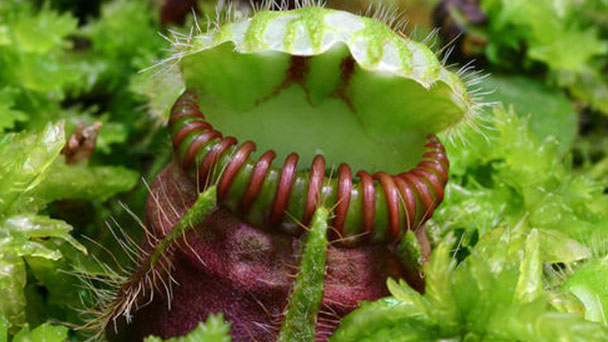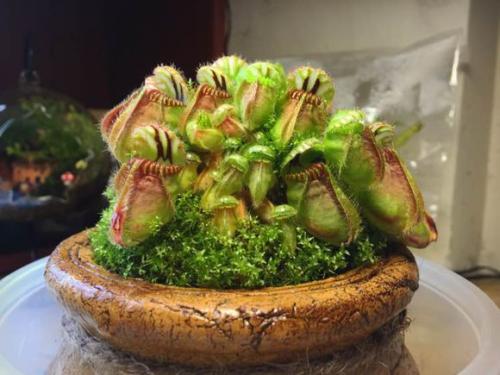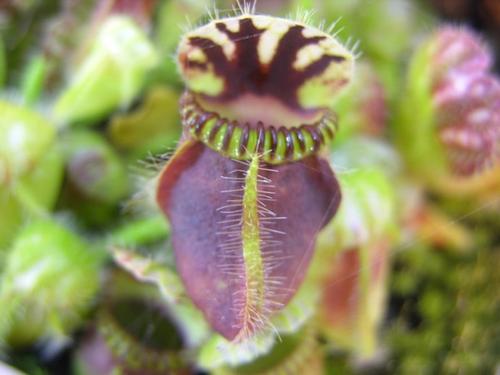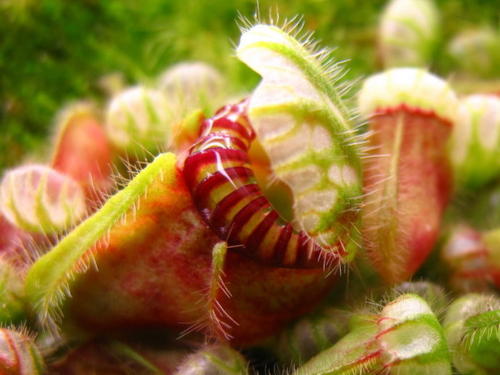Australian pitcher plant (Cephalotus follicularis) profile
Written by Maggie
Mar 18 2021

The Australian pitcher plant (Cephalotus follicularis) looked for water everywhere. The only species of Cephalotaceae, an Australian pitcher plant is native to south-western Australia. Australian pitcher plant is a perennial herb with a short woody underground stem. The flower is yellowish, its lower leaf is bottle - shaped, and is used to catch insects.
The trap of australian pitcher plant is similar to some species of pitcher plant, but unlike the pitcher plant, the stem is attached to the trap at the top of the back (the joint is at the bottom of the bottle). The cap is hairy and beautifully striped, and the mouth has a radial projection to form a groove that sticks out from the inside of the mouth to form a spiny object. The length of the cage varies from 4mm to 4.5cm, but most are around 3cm. In some individuals, the cages can grow up to 8cm in size. The cages are green in shade and colorful red and purple in light, but too much light can affect the size of the cages.
Australian pitcher plant picture

Morphological characteristics of Australian pitcher plant
The Australian pitcher plant has two kinds of leaves, one for photosynthesis like ordinary leaves, and the other, a pitcher for catching insects. It contains digestive juice and has a lid on the outside to prevent rainwater from running into it to dilute the juice. The lid has transparent spots, similar to the effect of blue sky, to confuse insects. The Australian Pitcher plant was previously placed in the genus Pitcheraceae, a member of the order Rosa, but in 1998 it was placed under the order Oxalis in a separate family by the APG classification based on genetic relation. Although the Australian pitcher plant is an insectivorous plant, a fly unique to Australia incubates its pupae in the leaves of the Australian pitcher. At present, the Australian pitcher plant has been introduced around the world as an ornamental plant. Australian pitcher plants look bright when they are in direct sunlight. It is green if it grows in shadows with plenty of light.
Ecological habits of the Australian pitcher plant
Australian Pitcher Plant (Cephalotus follicularis), a single genus and single species, is native to wetlands in south-western Australia. The first impression I got was that the plant was lovely. There were several chubby little brothers sitting on the grass in the sun. It looked like a fairy tale. Australian pitcher plant is found only in Australia. The leaves are shaped like little bottles with a lid.Insects that fall into it will melt and disappear over time. Perhaps the plant gets its food from insects. Pest trapping method: passive bag trapping. Caps can't move. The pouch and lid are purplish red in strong sunlight, and there are transparent Windows on the lid to attract insects. There are glands in the inside of the bag, and the mouth of the bag is slippery. Insects staying on the outside edge of the bag are easy to slip into the bag, and drown in the liquid inside the bag and be digested by the digestive juice.
How to grow and care for Australian pitcher plants
Light
When the temperature is below 18℃ and the humidity is above 90%, Australian pitcher plant can be in full sunshine. The bug bag is red, but small. When the humidity is low, Australian pitcher plant needs shading 30-50%. When the temperature is 18-35℃, the shading is 50%, and the insect trap bag is larger, but the color is green.Increasingly light turns the bug bag purplish red.
Humidity
In high humidity, the bug bag is larger, low humidity can also survive, but the bug bag. Smaller, the lid of the pouch seems to close during the hot and dry season. Usually Australian pitcher plant should be kept in a transparent cover or aquarium.
Watering
Rainwater, distilled water is the best, mountain spring water (EC<0.2) is fine. Tap water and acid rain water can not be used, the basin floor water plate installed about 0.2 cm of water, for the basin floor water absorption. Avoid water on the heart buds, so as not to rot.
Fertilizer
Never apply any chemical or organic fertilizer to Australian pitcher plant.
Dormancy
Australian pitcher plant doesn't sleep. If the plant suddenly Withers, check the root condition is still good, should immediately remove the withered old leaves, plant back to the original medium, keep the medium wet, about 2 months after the recovery of growth. If the situation does not improve, consider increasing sunlight or humidity. Leaves that grow in the spring do not form trap bags, but only in the summer season.

The propagation method of Australian pitcher plant
Australian pitcher plants can be used by seeding, dividing, and tissue culture.
Australian pitcher plant is one of the more unique species. The Australian pitcher plant has two forms of leaves at the same time: normal leaves and pitcher leaves (traps). Although the Australian pitcher plant works on the same principle: it lures prey into a pitcher, drowns it in digestive juice, decomposes it, and gets absorbed by glands inside the pitcher .But the way they set their traps is quite different. Bottle plants use honey secreted from their nectaries to attract prey, similar to the way people pay for bait in fishing. By contrast, the lovely Australian pitcher plant is much more advanced. It has long since abandoned the original means of luring prey with real objects and entered the information age, reaching a new level of "hunting for a white Wolf with nothing". Its pitcher cap the bar of the medial has 2 purple stripes, leads to the bottle, it looks flat structure is a mimicry creative behavior: general entomophily pollination tubiform floret had the same markings, which is a common evolution and some insects, the result of mutual selection, this information is expressed by the markings on insects have honeydew "inside," insect climbed into the flower also pollinate plants finished eating.
The Australian pitcher plant distribution
The Australian Pitcher plant is native to wetlands in south-west Australia.Introduced worldwide as a cultivated ornamental plant.
Use of the Australian pitcher plant
Australian pitcher plant can effectively reduce the number of agricultural pests and improve crop yield, especially the production of horticultural crops. It does not pollute the natural environment, and the agricultural products are free from pesticide residues, thus improving the quality of products. The effective period of pest control is long, especially for the perennial insectivorous plants, the pest control is effective for many years, and has the multipotency of pest control, which saves the manpower and material resources of application.

Latest Updated
- Benefits of Bugleweed - 7 Science-backed Health Benefits
- Bugleweed Dangers & Side Effects - Is It Poisonous?
- How to Plant Evergreen Trees - What You Should Know
- When to Plant Evergreens - Grow Guide for Evergreen Trees
- 12 Wonderful Evergreen Shrubs for Your Garden
- 12 Popular Evergreen Plants with Pictures for Beginners
- When And How To Prune A Lilac Bush Like a Pro
- How to Grow & Care for Lilac Vine (Hardenbergia Violacea)
- Japanese Lilac Tree (Syringa Reticulata) Care & Propagation Guide
- Shumard Oak Pros and Cons - What to Know
Popular Articles
- Winter maintenance of Antirrhinum Majus
- How to Grow Terminalia Mantaly Tree
- How to Grow and Care for Crossostephium Chinense
- How to grow Antirrhinum Majus in spring
- Peristeria Elata (Dove Orchid) Profile: Info & Care Guide
- Underwatered Snake Plant (Sansevieria Trifasciata) - Signs And How To Fix
- How to Care for Brazilian Jasmine Plant (Mandevilla Sanderi)
- How to Grow & Care for Graptopetalum Purple Delight in Summer
- Rosa Chinensis (China Rose): Plant Growing & Care Tips
- How to Care for Baby Sun Rose (Aptenia Cordifolia)